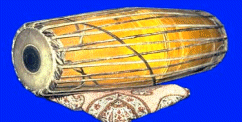Mridangam

Mridangam is a South Indian version of the pakhawaj. It bears a strong superficial resemblance to pakhawaj but there are major differences in construction and technique. The tone of the instrument is quite different. This is due to differences in construction.
The construction of the mridangam is interesting. It has heavy annular membrane around the right side, and a number of pieces of straw which are placed radially between the annular membrane and the main membrane. The right side has a permanent application, known as soru or karanai. The left side uses a mixture of flour and water to provide a proper tone. This application must be removed after each performance. The lacing and heads are all placed upon a barrel shaped wooden shell. The wood is usually of jackwood.
The instrument is usually tuned with a small wooden block and a heavy stone. The block is placed against the rawhide weaving and struck with the stone. The manner of striking may either raise or lower the pitch. It is generally tuned to the tonic of the piece being performed.
One sits cross legged with the left foot below and the right foot over and slightly extended. The mridangam rests upon the right foot and ankle. Since the instrument is very heavy it is also cushioned by some rolled up cloth placed at the right foot. The right hand plays the smaller head, while the left hand plays the head with the temporary application of flour.
The mridangam is an indispensable component of the south Indian classical performance. In these performances, the artist plays very intricate patterns to accompany south Indian vocalists, vina, violin, or gottuvadyam players. It is a very demanding art and requires many years to master.
